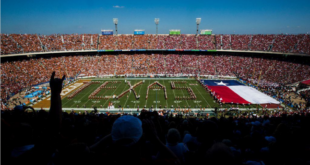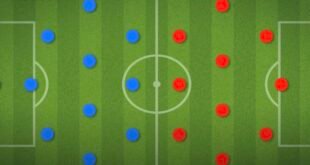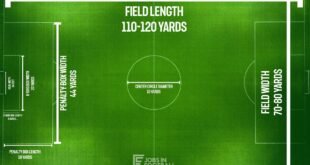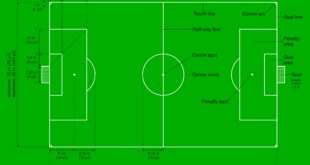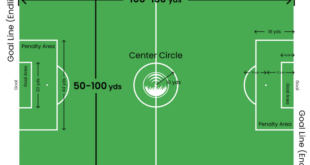A soccer field is generally larger, varying between 100 and 130 yards long and 50 and 100 yards wide. Football fields are 120 yards long, including end zones, and 53.3 yards wide.
Understanding the differences between soccer and football field sizes is essential for sports aficionados, athletes, and field designers. Soccer fields, or pitches, are adaptable in size, with international matches requiring specific dimensions. Contrastingly, American football fields maintain a consistent size across professional, college, and high school games.
The distinct sizes and markings of these fields are tailored to the unique rules and playstyles of each sport. This distinction in dimensions influences everything from gameplay and tactics to the conditioning of the athletes. Knowing these differences can enhance one’s appreciation of both soccer and football and is critical for those involved in sports planning and infrastructure.
🔴Soccer Field Vs Football Field Size🔴
Table of Contents
Introduction To Soccer And Football Fields
Imagine the roaring crowds, the vibrant green grass, and the thrill of the game. Both soccer and football fields are much more than just patches of grass; they are arenas where dreams come alive and legends are born. But aside from their pivotal role in hosting some of the most exciting sports events, do you know how they differ in size?
Soccer fields and football fields might look similar at first glance, yet their dimensions set them apart. Understanding these differences is key to appreciating each sport’s unique gameplay and culture.
The Essence Of Pitch Dimensions
Soccer and football games revolve around their fields, also known as pitches. A standard soccer pitch is rectangular, with specific length and width. The rules of soccer call for a pitch that is between 50-100 yards wide and 100-130 yards long. These dimensions can slightly vary, but they form the essential playing space for the sport.
In contrast, a standard American football field is more uniform in size. The field measures exactly 53.3 yards wide and 120 yards long. This includes two end zones which are 10 yards deep.
| Sport | Width (yards) | Length (yards) | End Zone (yards) |
|---|---|---|---|
| Soccer | 50-100 | 100-130 | N/A |
| Football | 53.3 | 120 | 10 (each) |
Soccer And Football: A Cultural Snapshot
The field sizes reflect the games’ different histories and cultures. Soccer, known worldwide as football, has its origins deeply rooted in many countries, with varied pitch sizes symbolizing the game’s universal appeal.
American football fields represent the precision and strategy of a game designed for meticulous planning and set plays. The fixed size showcases the structured nature of a sport that has evolved into a significant part of American culture.
- Soccer pitches accommodate various styles of play.
- Football fields cater to tactical exploits.
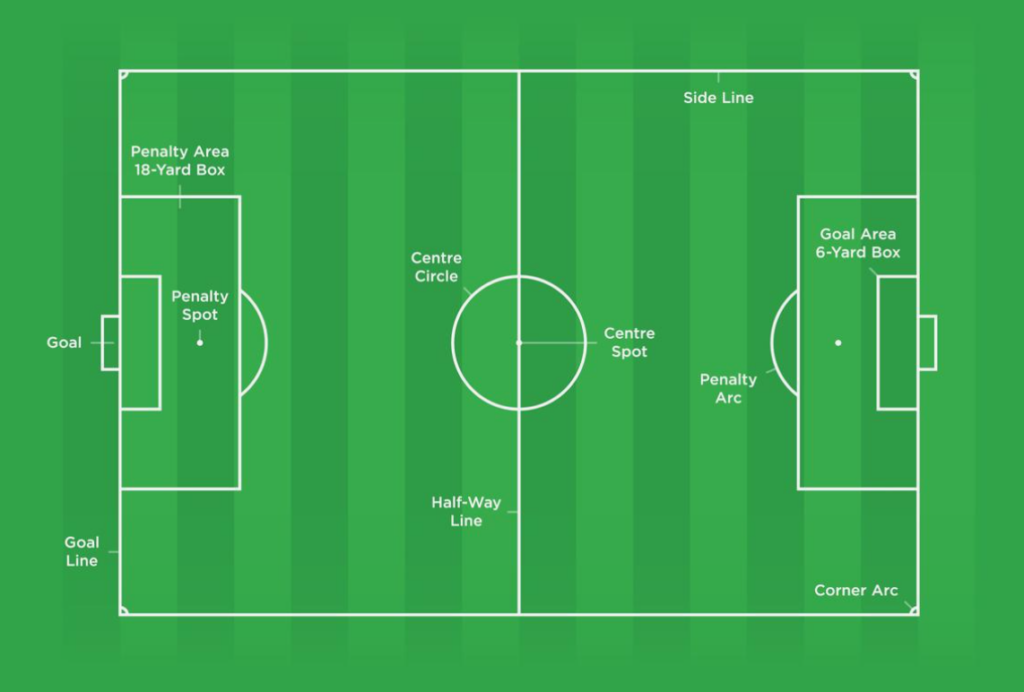
Soccer Field Explained
Understanding a soccer field is key to grasping the game’s rules. From local parks to professional stadiums, size and markings vary but follow certain guidelines. A well-defined soccer pitch contributes to the sport’s fairness and excitement.
Typical dimensions and markings
Typical Dimensions And Markings
Soccer fields range in length and width. Official dimensions make the game consistent worldwide. A standard field measures between 100 to 130 yards long and 50 to 100 yards wide. Each field features crucial markings such as the center circle, penalty area, and goal lines.
| Area | Dimension |
|---|---|
| Length | 100 to 130 yards |
| Width | 50 to 100 yards |
| Center Circle | 10-yard radius |
| Penalty Area | 18-yard box |
Regulatory bodies and their role
Regulatory Bodies And Their Role
FIFA and IFAB hold the torch for soccer rules. They ensure fair play and standardization worldwide. Local organizations also adapt these guidelines. FIFA’s Laws of the Game dictate pitch specifics, amended when needed for play integrity. Schools and clubs must align their fields to these standards to host official matches.
- FIFA: Sets global standards
- IFAB: Maintains and updates rules
- Laws of the Game: Soccer’s rulebook
Football Field Unpacked
A football field is more than just a playing ground; it’s a stage for athleticism and strategy. With precise dimensions forming its design, understanding a football field’s layout is crucial for players and fans alike. Let’s delve into the specifics that make a football field, beginning with its standard dimensions.
Standard Football Field Dimensions
When we talk about the size of a football field, there’s an established norm that most fields adhere to.
This includes the playing field and the surrounding area.
| Segment | Length | Width |
|---|---|---|
| Playing Field | 100 yards | 53 1/3 yards |
| End Zone | 10 yards (each) | 53 1/3 yards |
| Total Length | 120 yards | 53 1/3 yards |
Knowing these dimensions helps players understand the field they’re working with.
It also aids coaches in planning tactics. Fans can appreciate the skill it takes to cover such an expanse.
End Zones And Hash Marks
The end zones and hash marks bring unique characteristics to a football field.
End zones mark the scoring areas, while hash marks guide the setup for each play.
- End zones: A 10-yard deep space at each end of the field.
- Hash marks: Small lines on the field indicating where the ball starts each play.
- They are 1 yard apart.
- Run the length of the field.
Together, end zones and hash marks are integral to the game.
They determine critical points like touchdowns and play starting positions.
They make the game structured and fair for both teams.
Comparing Field Sizes
Soccer and football are two of the most loved sports worldwide.
Each has a unique field size that enhances the game in its own way.
Let’s dive into a side-by-side comparison and see how these dimensions impact gameplay.
Side By Side Comparison
| Soccer Field | Football Field |
|---|---|
| Length: 100-130 yards | Length: 120 yards |
| Width: 50-100 yards | Width: 53.3 yards |
| Shape: Rectangular | Shape: Rectangular |
| Goal size: 8 feet by 24 feet | End zone: 10 yards deep |
Impact Of Size On Gameplay
The field size in any sport is not just a boundary. It shapes the pace and style of the game.
- Larger soccer fields allow more space for players to maneuver and strategize.
- Narrower football fields create a more congested play, focusing on direct advances.
Each sport demands specific physical attributes and skills, largely due to their field’s characteristics.
Variances Across Different Leagues
Soccer and football fields look similar. They are not the same size. Different leagues play on different size fields. Let’s look at how sizes change across these sports.
Global Football Field Dimensions
Soccer fields vary worldwide.
This is because FIFA allows range in size.
- Length: 100-110 meters (or 110-120 yards)
- Width: 64-75 meters (or 70-80 yards)
| League | Minimum Size (meters) | Maximum Size (meters) |
|---|---|---|
| Premier League | 100 x 64 | 105 x 68 |
| La Liga | 100 x 64 | 105 x 68 |
| Serie A | 100 x 64 | 110 x 75 |
Big competitions like the World Cup use the larger sizes.
American Football Field Regulations
American football fields have strict sizes.
The NFL has set dimensions.
- Length: 120 yards (including end zones)
- Width: 53.3 yards
- End Zone: Each is 10 yards deep
Colleges and high schools use the same sizes.
Yard lines help players and fans see distance.
All NFL fields must follow these rules.
The Role Of Field Size In Gameplay Strategy
Field size greatly influences gameplay in sports. In soccer and football, the field dimensions shape how teams strategize and engage during the game. Larger areas demand stamina and wider tactical awareness. Smaller pitches intensify the action, requiring quick reflexes and decision-making.
Tactics On The Soccer Pitch
Soccer, known as football outside North America, is played on a large field. Here are ways this impacts strategy:
- Spread the defense: Teams use wide fields to stretch opponents’ defenses.
- Control possession: More space allows for better ball retention.
- Stamina and speed: Players must maintain these to cover large distances.
Coaches adapt formations based on field size. A larger pitch may lead to using a 4-3-3 formation. This leverages width and space to attack.
Strategy On The Football Field
American football fields have set sizes with different strategies:
- Time management: Field size lets teams plan plays to manage the clock.
- Play selection: Big end zones influence pass and run play decisions.
- Special teams: Field goals and punts vary with field length and wind.
Teams tailor their playbooks for field dimensions. Smaller fields may see more short-passing plays. Larger end zones favor pass-heavy strategies.
| Sport | Field Length | Field Width | End Zone/Area |
|---|---|---|---|
| Soccer | 100-110 meters | 64-75 meters | N/A |
| Football | 120 yards (including end zones) | 53.3 yards | 10 yards deep |
Surrounding Infrastructure And Facilities
When comparing soccer and football fields, it’s not just the size that matters. The infrastructure and facilities around them play crucial roles in both player performance and fan experience. These include stadium seating, field access, lighting, and turf technology.
Stadium Seating And Field Access
Stadium seating design varies greatly between soccer and football stadiums. Key differences include:
- Capacity: Football stadiums are often larger.
- Proximity: Soccer fans enjoy a closer view of the action.
- Accessibility: Safe and efficient field access is a top priority.
Field access points, such as tunnels and entryways, must accommodate players, staff, and emergency services. Every facility aims for streamlined movement in and out of the field area.
Lighting And Turf Technology
Lighting systems and turf quality are pivotal for optimal gameplay:
| Feature | Soccer Fields | Football Fields |
|---|---|---|
| Lighting | Consistent, wide-angled illumination | Bright lights with focused beams |
| Turf | Short grass for ball control | Durable turf to withstand tackles |
Innovative lighting enhances visibility for players and spectators alike. Advanced turf technologies ensure high-quality surfaces that are safe and responsive.
Cultural Significance And Field Design
A soccer field and a football field stand as giants in the world of sports. They are more than playing surfaces. They hold deep roots in cultures around the globe. These fields share markings, grass, and goals. Yet, they reflect unique community values. The design of these fields carries a story of tradition, passion, and modern evolution.
Fields As Community Landmarks
Sporting arenas become landmarks within their communities. Let’s delve into how they gain such status.
- Identity: Fields are often named after local heroes or historical events.
- Gathering Spots: They are the go-to places for local festivities and sports events.
- Pride: Home games turn fields into stages for community pride and spirit.
These landmarks stand for unity. They bind different generations. They bring life to neighborhoods.
Field Design Trends And Their Meaning
The soccer and football fields of today echo modern aesthetics and practicality. Here are some key trends:
| Trend | Meaning |
|---|---|
| Eco-Friendly Materials | Commitment to sustainability |
| Multifunctional Spaces | Community inclusivity |
| Advanced Drainage Systems | Optimal playing conditions |
Each design aspect serves a purpose. Fields now speak to environmental responsibility. They allow more than just sports. They ensure player safety.
Future Developments In Field Design And Size
Sports enthusiasts and architects constantly innovate field designs to enhance game quality.
Let’s explore cutting-edge advancements in field design and size that may shape the future of soccer and football.
Emerging Technologies In Sports
Emerging technologies transform sports fields. Athletes and fans will witness innovative changes.
- Smart turfs with embedded sensors to measure player performance.
- LED lighting systems that adjust to weather and time for optimal visibility.
- Drainage technologies to keep fields dry and safe in any weather.
Potential Changes In Regulations
The rules governing field size may evolve. Changes aim to improve player safety and game dynamics.
| Current Regulation | Potential Change | Impact |
|---|---|---|
| Field Dimensions | Adjustable boundaries | More dynamic gameplay |
| Surface Material | Eco-friendly alternatives | Sustainability focus |
| Safety Standards | Enhanced protocols | Decreased injury risk |
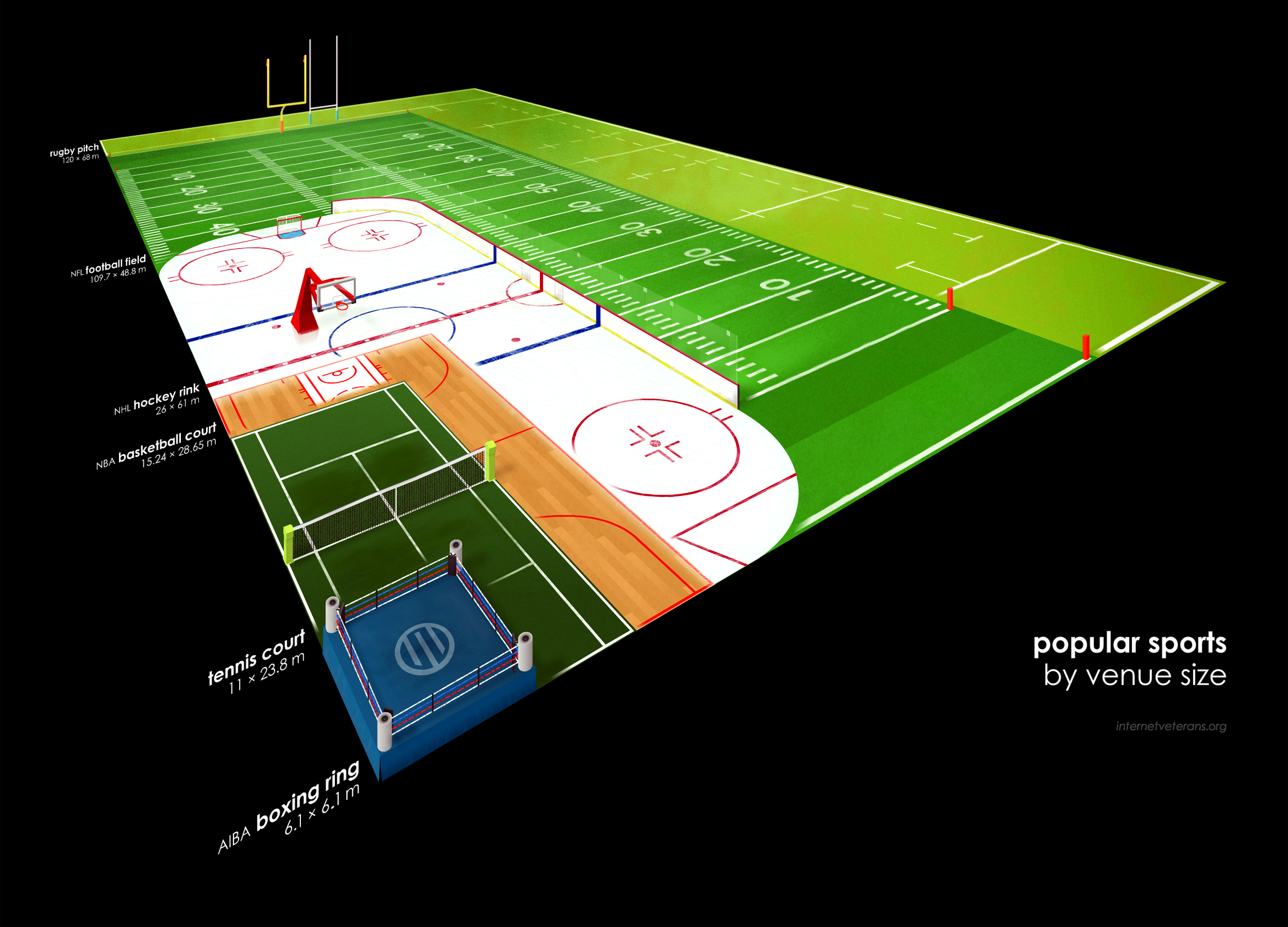
Frequently Asked Questions For Soccer Field Vs Football Field Size
Are Soccer Fields Larger Than Football Fields?
Soccer fields, officially known as football pitches, typically range from 100 to 130 yards in length and 50 to 100 yards in width. American football fields are smaller, with a fixed length of 120 yards, including end zones, and a width of 53.
3 yards. Therefore, soccer fields can be larger.
What are Standard Soccer field Dimensions?
A standard soccer field is 115 yards long and 74 yards wide. However, the Laws of the Game permit some flexibility, allowing lengths between 100 and 130 yards and widths between 50 and 100 yards. These dimensions may vary based on league regulations and levels of play.
How big are Professional football fields?
Professional football fields in the U. S., like in the NFL, have standard dimensions of 120 yards in length, including two 10-yard-deep end zones, and 53. 3 yards in width. The playing field itself is 100 yards long, with hash marks and sidelines marking boundaries.
What size are high School Soccer fields?
High school soccer fields can vary, but they generally measure shorter and narrower than professional pitches. They often fall within the range of 100 to 120 yards in length and 55 to 80 yards in width, adhering to the national federation state or local district regulations.
Conclusion
Understanding the dimensions that differentiate a soccer field from a football field can enhance your appreciation for both sports. Each game’s unique strategies are partly shaped by its playing field’s size constraints. Whether you’re a player, a coach, or a fan, recognizing these differences can deeply enrich your engagement with the game.
 Cric Enjoy Sports News, Cricket Update, Live Streaming
Cric Enjoy Sports News, Cricket Update, Live Streaming
